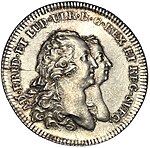Adolf Frederick of Sweden
This article needs additional citations for verification. (August 2007) |
| Adolf Frederick | |
|---|---|
Riddarholm Church | |
| Spouse | |
| Issue | Gustav III of Sweden Charles XIII of Sweden Prince Frederick Adolf, Duke of Östergötland Sophia Albertina, Abbess of Quedlinburg |
| House | Holstein-Gottorp |
| Father | Christian August of Holstein-Gottorp, Prince of Eutin |
| Mother | Princess Albertina Frederica of Baden-Durlach |
| Religion | Lutheranism |
| Signature | |
Adolf Frederick, or Adolph Frederick (
The first king from the House of Holstein-Gottorp, Adolf Frederick was a weak monarch, installed as first in line to the throne following the parliamentary government's failure to reconquer the Baltic provinces in 1741–1743. Aside from a few attempts, supported by pro-absolutist factions among the nobility, to reclaim the absolute monarchy held by previous monarchs, he remained a mere constitutional figurehead until his death.
His reign saw an extended period of internal peace. However, the finances stagnated following failed
Ancestry
Adolf Frederick's father was
His mother,
Reign


From 1727 to 1750 Prince Adolf Frederick was the prince-bishop of

In 1743, Adolf Frederick was elected heir to the throne of Sweden by the Hat faction (Swedish: Hattarna). The Hat faction wanted to obtain better conditions at the Treaty of Åbo from Empress Elizabeth.[5] He succeeded to the Swedish throne on 25 March 1751.[8]
During his 20-year reign, Adolf Frederick was little more than a figurehead, the real power being with the Riksdag of the Estates, often distracted by party strife. Twice he endeavored to free himself from the tutelage of the estates. The first occasion was in 1756. Stimulated by his consort Louisa Ulrika of Prussia (sister of Frederick the Great), he tried to regain a portion of the attenuated prerogative through the Coup of 1756 to abolish the rule of the Riksdag of the Estates and reinstate absolute monarchy in Sweden. He nearly lost his throne in consequence. On the second occasion during the December Crisis of 1768, under the guidance of his eldest son, Gustav, he succeeded in overthrowing the "Cap" (Swedish: Mössorna) senate, but was unable to make any use of his victory.[5][9]
Death
Adolf Frederick died suddenly in Stockholm on 12 February 1771 with symptoms resembling either heart failure or poisoning. Popular stories about his death having resulted from a large meal (consisting of lobster, caviar, sauerkraut, kippers, and champagne as well as 14 helpings of his favourite dessert hetvägg of semla pastries and hot milk)[10][11] are considered propaganda by modern writers.[12]
Following his death, his son Gustav III seized power in 1772 in a military coup d'état, reinstating absolute rule.[13]
Legacy
The King was regarded as dependent on others, a weak ruler, and lacking of any talents as a statesman. However, he was allegedly a good husband, a caring father, and a gentle master to his servants. He was scientifically talented and especially interested in astronomy. He also had talent in military matters and in music. His favourite pastime was woodworking, especially to make
Children

By his marriage to Princess Louisa Ulrika of Prussia (which took place on 18 August/29 August 1744 in Drottningholm), he had five children:
- (Stillborn) (18 February 1745 in Stockholm)
- Gustav III (1746–1792)
- Charles XIII (1748–1818)
- Frederick Adolf (1750–1803)
- Sofia Albertina (1753–1829)
With Jeanne Du Londel he had one son:
- Adolf Fredriksson (c. 1734-1771), Captain in the Swedish Army.[15]
With
- Frederici (c. 1761 - 1771)[16]
Adolf Frederick may have been the father of Lolotte Forssberg by Ulla von Liewen, but this has never been confirmed.[17]
Ancestors
| Ancestors of Adolf Frederick of Sweden Marie Elisabeth of Saxony (=9) | | |||||||||||||||
|---|---|---|---|---|---|---|---|---|---|---|---|---|---|---|---|---|
| 31. Magdalene Sibylle of Prussia (=19) | ||||||||||||||||
References
- ^ L. Stavenow. "Adolf Fredrik". Svenskt biografiskt lexikon. Retrieved 1 January 2019.
- ^ "Christian August, Herzog von Schleswig-Holstein-Gottorp". Christian August (Herzog von Holstein-Gottorf). Allgemeine Deutsche Biographie. Allgemeine Deutsche Biographie. 1876. p. 192. Retrieved 1 January 2019.
- ^ "Adolf Fredrik". Nordisk familjebok. Retrieved 1 January 2019.
- ^ ISBN 9780852295298.
- ^ a b c One or more of the preceding sentences incorporates text from a publication now in the public domain: Chisholm, Hugh, ed. (1911). "Adolphus Frederick". Encyclopædia Britannica. Vol. 1 (11th ed.). Cambridge University Press. pp. 211–212. This cites:
- R. Nisbet Bain, Gustavus III. and his Contemporaries, vol. i. (London, 1895).
- ^ Nina Ringbom. "Kristina Magdalena av Pfalz-Zweibrücken". historiesajten.se. Retrieved 1 January 2019.
- ^ "Peter III". Saint-Petersburg.Com. Retrieved 1 January 2019.
- ^ "Hattpartiet, Hattarna". Nordisk familjebok. Retrieved 1 January 2019.
- ^ "Mösspartiet, Mössorna". Nordisk familjebok. Retrieved 1 January 2019.
- ^ "The lowdown on Sweden's best buns". The Local. February 2007. Archived from the original on 16 February 2008.
- ^ Carlstedt, Magnus. "Hetvägg". semlor.nu. Archived from the original on 3 August 2020. Retrieved 1 January 2019.
- ^ Such as Claes Rainer 2021 in Sofia Magdalena : kärlek, revolutioner och mord ISBN 9789198624915 pp. 152-153
- ^ "Gustav III (January 24, 1746 – March 29, 1792)". European Royal History. Retrieved 1 January 2019.
- ^ Book listed at LIBRIS p. 209
- ^ Rainer, Claes (2019). Lovisa Ulrika: konst och kuppförsök. Stockholm: Bokförlaget Langenskiöld
- ISBN 91-7054-734-3
- ^ af Klercker, Cecilia, ed. Hedvig Elisabeth Charlottas dagbok [The diary of Hedvig Elizabeth Charlotte] (in Swedish). VI 1797-1799. (1927) Translated by Cecilia af Klercker. Stockholm: P.A. Norstedt & Söners förlag. pp. 290–291
- ^ Genealogie ascendante jusqu'au quatrieme degre inclusivement de tous les Rois et Princes de maisons souveraines de l'Europe actuellement vivans [Genealogy up to the fourth degree inclusive of all the Kings and Princes of sovereign houses of Europe currently living] (in French). Bourdeaux: Frederic Guillaume Birnstiel. 1768. p. 28.
External links
 Media related to Adolf Frederick of Sweden at Wikimedia Commons
Media related to Adolf Frederick of Sweden at Wikimedia Commons
